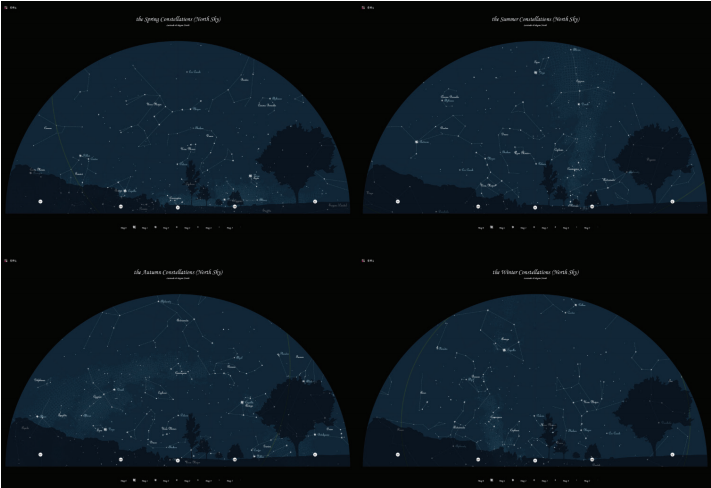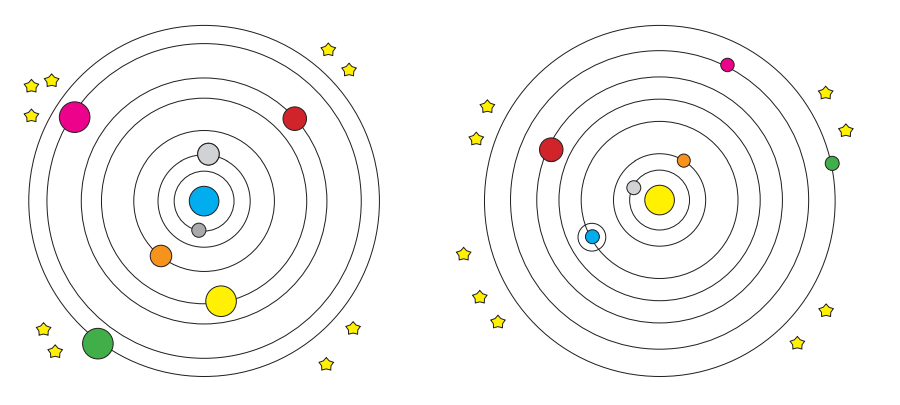INTRODUCTION
From a young age, we have been taught that the Sun rises from the East and sets in the West every day, and everyone can see how our light, after its rise, reaches its maximum height around noon and then begins to "fall" until it disappears below the western horizon. We see the same thing with the Moon - it also rises from the East, raises high into the sky and then sets in the West. Planets, comets and asteroids have the same behaviour.
Motion of celestial objects (visible, real)
Interesting facts
The word „изток“ („east“ – in a sense „cardinal direction in the direction of a rising sun“, but also „rising of the Sun“) in Bulgarian – and perhaps in other Slavic languages – comes from or has something to do with words „изтичам“ („to leak“), „извор“ („spring“) and is close to the word „изгрев“ („rise“ – in a sense „sunrise“). Slovo „запад“ („west“) probably comes from the word„западам“ („sink“), and forms the basis of the word „залез“ („set“ – in a sense „sunset“).
The sun played an important role in word formation in Slavic languages.
According the etymology of the word „изток“ („east“ as one of the cardinal directions) we find that this word comes from the term the Sun rising - we observe its movement from the horizon upwards. Prefix „из-“ („vy-“/„vý-“ means the performance of an action directed outwards or upwards and the base „ток“ („tok“) can be connected to „течение“ („stream“) and „поток“ („creak“). In other Slavic languages, the word „východ“ is spelled similarly (východ – russian; wschód – polish; na východě – czech; východ – slovak).
If we think about the origin of the word "west", we again find a connection between its composition and the sign of the Sun's descent - we observe a downward movement, towards the horizon. The prefix ZA is the meaning of the action until the end and PAD comes from the "fall". The reference to other Slavic languages confirms this statement („запад“ – in russian; „zachód“ – in polish; „západně“ – in czech; „západ“ – in slovak).
The same connection between Slavic languages can be also found in words „изгрев“ („sunrise“) a „запад“ („sunset“).The following words are used for „изгрев“ („sunrise“): „восход солнца“ in russian, „wschód słońca“ in polish, „východ slunce“ in czech, „východ slnka“ in slovak. The word „залез“ („sunset“) reads in the various languages as follows: „zachód słońca“ – in polish; „ západ slunce“ – in czech; „ západ slnka“ – in slovak.
Movement of the stars
If we go outside on a clear, cloudless night and watch for a long time what is happening to the stars, we will notice that some stars are rising from the east and others are not setting in the west. On closer observation, we see that each star repeats the same motion as the Sun and Moon - rising from the east, reaching its highest point in the sky (which astronomers refer to as the "upper culmination"), and then descending somewhere to the west.
The exception is a small group of stars that neither rise nor descend. They also rise to the highest point (upper culmination), then descend to their lowest point (lower culmination), but never exceed the horizon. These stars appear to orbit the Pole Star, and if we take pictures of them for several hours, we will see that they form circles in the sky that are part of a circle centred somewhere near the Pole Star (or North Celestial Pole). Such constellations are called non-fitting or circumpolar constellations.
For Bulgaria, the circumpolar (ocular polar) constellations are the Little Bear, the Big Bear, the Draco, the Cepheus, the Cassiopeia, the Cam and the Lynx.

There are also stars that we, in Europe, will never see. They, and the constellations in which they are located, are called "non-fitting." The groups of non-setting and non-rising constellations are different at different points on the Earth, depending on latitude or distance from the equator. When one is at the equator, one sees all the constellations. The closer the person is to the equator, the less non-setting and non-rising constellations he/she sees. By moving away from the equator, their number increases. From the pole (both from the north and from the south) we see exactly half of the stars, which never set and describe circles in the sky parallel to the horizon. The other half of the stars will never reach the horizon and will remain invisible from this pole forever.
In the case of Europe, there is an invisible part of the southern constellations that are close to the South Pole (the Southern Cross, the Toucan, the Octans, the Table Mountain, the Fly etc.).
Visible movement of celestial objects
The movement of the celestial objects that we observe during one day and night - their rise, ascent to the upper peak (upper culmination), their set and rise the next day, is called the visible 24-hour movement (celestial sphere).
Imagine that we make observations for a few weeks or months. It immediately gives us the impression that at the same time as the previous day or night, the sky is different. The constellations we saw before rising are now higher in the sky, and new constellations are rising in their place on the eastern horizon. Looking west, we see the constellations that were higher above our heads, and we no longer see the stars that had previously set there.
In a few months, this picture of the sky will change even more. Now we will see completely different stars, with the exception of the stellar constellations, which are always above the horizon but have only turned slightly. This is why we conditionally divide the constellations into "winter", "spring", "summer" and "autumn" according to whether they are visible in the evening after sunset at a given time of year. In the case of the northern hemisphere (where Europe is also located), the "winter" constellations are the constellations Orion, Taurus, Gemini, Greater Dog, Lesser Dog and others. The "spring" constellations are the constellations Leo, Virgo, Hydra, Raven, Cup, etc. The constellations Sagittarius, Scorpio, Ophiuchus, Lyra, Swan, and Altair are part of the "summer" constellations. The constellations Andromeda, Persia, Pegasus, Capricorn, Pisces, and Aries are part of the "autumn" constellations.

The movement of the Sun, Moon and planets also changes during the year. In winter the sun rises late in the morning, much more in the southeast, rises very low over the horizon, sets early in the southwest and the day is, at the expense of a long night, very short. In summer it is just the opposite - the sun rises very early, except for the northeast, it is very high at noon, it sets late in the northwest direction, the day is very long with a short night. The movement of the Moon is also seasonal, but its description is much more complicated.

These differences in the movement of the Sun during the year also depend on the latitude and position of the observer on the Earth. They are less conspicuous around the equator and completely opposite at the North or South Pole. In the ocular polar regions of the Earth, we speak of a polar day or a polar summer, when the Sun does not set for months to half a year, and a polar night or a polar winter, during which the Sun does not rise from the horizon at all.
We call the visible annual movement (celestial sphere) the movement of the celestial objects during the year - their different visibility in different seasons.
Geocentrism a heliocentrism
Thousands of years ago, these movements, which we now call visible 24-hour or annual movements, were thought to be caused by the very movement of the stars, the Sun, the Moon, and the planets around the Earth (or the whim of the gods). Then people believed that the Earth was the centre of the Universe, and all other celestial objects revolved around it. Today we call this a "geocentric system" after the name of the earth goddess in the ancient Greek mythology (Gaia). For centuries, astronomers have had to fight this notion of ordinary people, and even at the cost of their lives, to convince people (and the Church) that it is not the Earth but the Sun that is at the centre of this movement. And so, in the 16th and 17th centuries, this idea was replaced by the "heliocentric system" after the name of the sun god in the ancient Greek mythology (Helios). Today we already know that the Sun is the centre of only the Solar System, but the Universe is infinite and has no centre.

People's belief in a geocentric system is the result of the fact that we, humans on the Earth, do not feel its movement. And the Earth is still moving! At first, the Earth rotates around its imaginary axis for almost 24 hours (more precisely 23 hours, 56 minutes and 4 seconds) or in other words, a point from the equator moves around the centre of the Earth at a speed of about half a kilometre per second (0.47 km/s, resp. 1674.4 km per hour). One rotation of the Earth around its axis is called "day" ("star day"). All points on the Earth's surface in one day (24 hours) describe a circle with the middle centred on its axis. These circles have different radii and velocities at which different points move, differing from each other - the farther we are from the equator, the less we rotate around the axis. But even so, the daily paths of each point on the Earth are essentially circles, with each circle having 360 degrees. If we divide 360 degrees into 24 hours, it turns out that the Earth rotates around its axis by 15 degrees in one hour.
Earth´s movement
This is the real daily movement of the Earth, which causes the visible daily movement of the celestial objects. The Earth rotates around its axis counter clockwise - when viewed from its north pole, resp. from west to east, and this is why we see all the lights in the sky rising from the east and heading west. This visible daily movement occurs at the speed at which the Earth rotates around its axis - 360 degrees in one day or 15 degrees in one hour.
The Earth orbits the Sun in an ellipse, taking 365 days, 6 hours, 9 minutes and 10 seconds. We call this period "a year" ("star year"). Although we do not feel this movement, it turned out that we humans, together with the planet Earth, fly around the Sun at a speed of almost 30 km per second (107,218 km/h)! We call this movement of the Earth around the Sun a real annual movement of the Earth, which causes a visible annual movement of the celestial objects. This is actually due to the fact that we see different constellations during different seasons at the same time.
The planets, which also rise from the east and set to the west, are again affected by the actual daily and annual movement of the Earth and their own movement around the Sun. Therefore, we can see a planet moving day by day between the stars from the west to the east, sometimes "rotating" its direction (moving retrogradely), creating strange "loops" in the sky, and again heading in the "right direction." This is the obvious visible annual movement of the planets. The time it takes for the planet to return to the same constellation is the time it actually takes to orbit the Sun. In this way, even centuries ago, the astronomers calculated the times of their orbital motion.

The movement of a single natural object orbiting the Earth, which we call the visible motion of the Moon in the sky, therefore also depends not only on the real motion of the (real) Moon, but also on the real daily and annual motion of the Earth. The Moon also rises from the east and sets in the west, but between the stars, like the Sun and the planets, it moves from west to east. However, this movement lasts 27.32 days, which is also the time of its orbit around the Earth. If we add to these movements the fact that the Moon orbits the Earth orbiting the Sun, we can explain its so-called lunar phases, as well as many other phenomena, such as solar and lunar eclipses.


